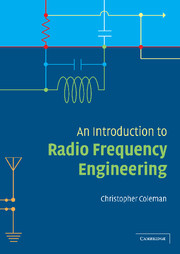Book contents
- Frontmatter
- Contents
- List of figures
- Preface
- Acknowledgements
- 1 Basic concepts
- 2 Frequency selective circuits and matching
- 3 Active devices and amplifiers
- 4 Mixers, modulators and demodulators
- 5 Oscillators and phase locked loops
- 6 Transmission lines and scattering matrices
- 7 Power amplifiers
- 8 Filters
- 9 Electromagnetic waves
- 10 Antennas
- 11 Propagation
- 12 Digital techniques in radio
- Index
7 - Power amplifiers
Published online by Cambridge University Press: 05 June 2012
- Frontmatter
- Contents
- List of figures
- Preface
- Acknowledgements
- 1 Basic concepts
- 2 Frequency selective circuits and matching
- 3 Active devices and amplifiers
- 4 Mixers, modulators and demodulators
- 5 Oscillators and phase locked loops
- 6 Transmission lines and scattering matrices
- 7 Power amplifiers
- 8 Filters
- 9 Electromagnetic waves
- 10 Antennas
- 11 Propagation
- 12 Digital techniques in radio
- Index
Summary
RF signals will often need to be transmitted with considerable power if they are to survive propagation with adequate signal level. As a consequence, we will need to consider amplifiers that can operate at large signal levels. Up to this point, we have concentrated on small signal amplifiers for which efficiency and linearity have not been a major problem. These aspects, however, require careful consideration in the case of RF amplifiers operating at large signal levels. Small signal amplifiers are typically of the class A variety and highly linear. Whilst class A amplifiers are sometimes used at high power levels, they do not represent an efficient use of the d.c. energy that is supplied to the amplifier. Class B, AB, C and E amplifiers are far more efficient, but have the disadvantage that they are highly non-linear and hence create considerable harmonics. These harmonics can be troublesome and require specialised techniques, or filtering, for them to be brought down to an acceptable level. The following chapter considers power amplifiers in the class range from A to E. It concentrates on BJT amplifiers, but the same principles can be applied to FET amplifiers.
Class A
Class A amplifiers attempt to operate over that part of the transistor characteristic for which there is linear translation of the input signal to the output. For a BJT, a typical configuration is shown in Figure 7.1.
- Type
- Chapter
- Information
- An Introduction to Radio Frequency Engineering , pp. 171 - 186Publisher: Cambridge University PressPrint publication year: 2004



